1996 BUICK REGAL lights
[x] Cancel search: lightsPage 12 of 356
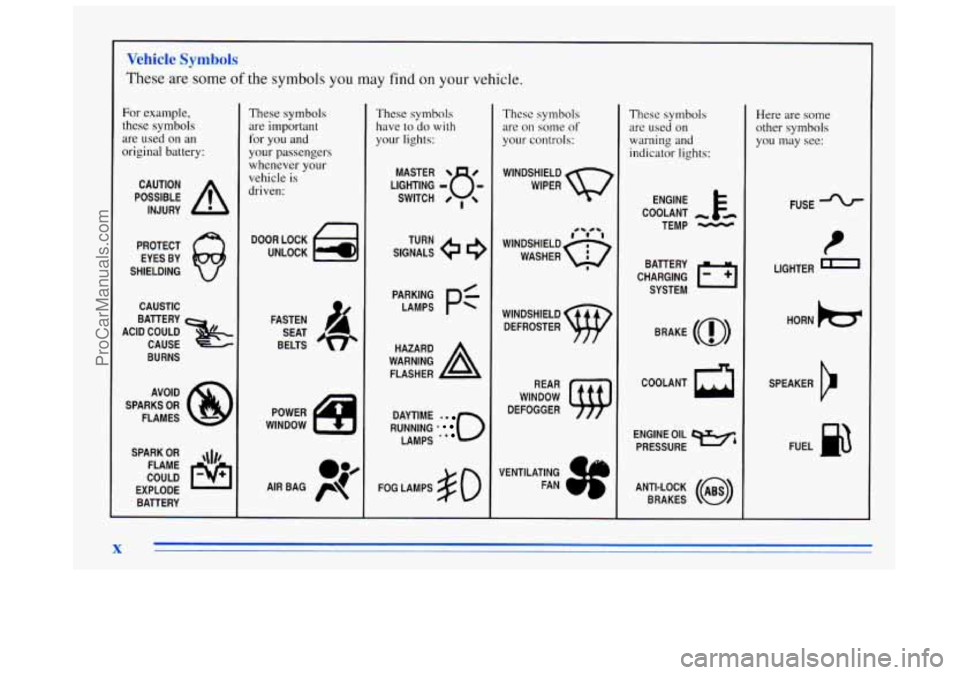
Ve hide bols
These are some of the symbols you may find on your vehicle.
For example,
these symbols
are used on an
original battery:
POSSIBLE A
CAUTION
INJURY
PROTECT EYES BY
SHIELDING
CAUSTIC
BURNS AVOID
SPARKS
OR
FLAMES
SPARK
OR ,\I/,
COULD FLAME
EXPLODE BATTERY
These symbols
are important
for you and
your passengers
whenever
your
vehicle is
driven:
DOOR LOCK
UNLOCK
FASTEN SEAT
BELTS
POWER
WINDOW
These symbols have to do
with
your lights:
SIGNALS e
TURN
RUNNING
* 0
DAYTIME ..
LAMPS .*
FOG LAMPS # 0
These symbols
are
on some of
your controls:
WINDSHIELD
WIPER
WINDSHIELD DEFROSTER
WINDOW
DEFOGGER
VENTILATING FAN
1 d J
These symbols
are used on
warning and
indicator lights:
ENGINE F-
COOLANT -
TEMP -
CHARGING I-1
BAllERY
SYSTEM
BRAKE
(a)
COOLANT a
ENGINE OIL e,
PRESSURE
ANTI-LOCK
(@)
BRAKES
Here are some
other symbols
you may see:
FUSE
t
LIGHTER n
HORN hs
SPEAKER
b
FUEL p3
ProCarManuals.com
Page 76 of 356

A E
C
With the ignition key in the ignition switch, you can turn
the switch to five positions.
ACC (A): This position lets you use the radio and
windshield wipers when the engine is
off. To use
ACC (Accessory), push in the key and turn
it toward
you. Your steering wheel will stay locked.
LOCK (B): Before you put the key into the ignition
switch, the switch is in
LOCK. It’s also the only position
in which you can remove your key. This position locks your
ignition, steering wheel and transaxle. It’s
a
theft-deterrent feature.
OFF (C): This position lets you turn off the engine but
still turn the steering wheel. It doesn’t lock the steering
wheel like LOCK. Use OFF
if you must have your
vehicle pushed or towed.
RUN (D): This position is where the key returns after
you start your vehicle. With the engine
off, you can use
RUN to display some of your warning and indicator lights.
START (E): This position starts your engine.
A warning chime will sound if you open the driver’s
door when the ignition is
in OFF, LOCK or ACC ,and
the key is in the ignition.
- .. - _- -
NOTICE:
If your key seems stuck in LOCK and you can’t
turn it, be sure
it is all the way in. If it is, then
turn the steering wheel left and right while you
turn the key hard. But turn the key only with
your hand. Using
a tool to force it could break
the key or the ignition switch.
If none of this
works, then your vehicle needs service.
ProCarManuals.com
Page 98 of 356

Lamps
The lamp controls are on the instrument panel. They
control these systems:
Headlamps
Taillamps
Parking Lamps
License Lamps
0 Sidemarker Lamps
0 Instrument Panel Lights
0 .Courtesy Lamps Turn
the knob
to ON to turn on the headlamps and other
operating lamps.
Turn the knob to
PARK to turn on the parking and other
operating lamps without the headlamps.
Turn the knob to
OFF to turn off the lamps.
A warning chime will sound when you turn the ignition
switch to
OFF, LOCK or ACC with the lamps on.
Daytime Running Lamps (Option)
Daytime Running Lamps (DRL) can make it easier for
others to see the front
of your vehicle during the day.
DRL can be helpful in many different driving
conditions, but
they can be especially helpful in the
short periods after dawn and before sunset.
A light sensor on top of the instrument panel makes the
DRL work, so be sure it isn’t covered.
The DRL system will make your low-beam headlamps
come on at a reduced brightness when:
0 The ignition is on,
The headlamp switch is off, and
The parking brake is released.
2-32
ProCarManuals.com
Page 99 of 356
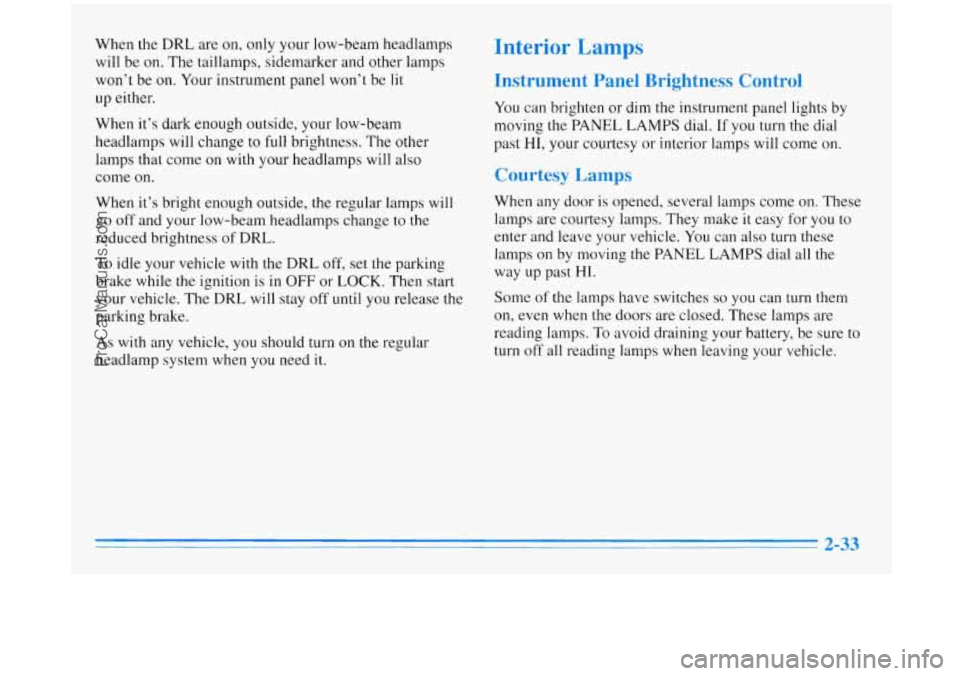
When the DRL are on, only your low-beam headlamps
will be on. The taillamps, sidemarker and other lamps
won’t be on. Your instrument panel won’t be lit
up either.
When it’s dark enough outside, your low-beam
headlamps will change to
full brightness. The other
lamps that come on with your headlamps will also
come on.
When it’s bright enough outside, the regular lamps will
go off and your low-beam headlamps change to the
reduced brightness of DRL.
To idle your vehicle with the DRL off, set the parking
brake while the ignition
is in OFF or LOCK. Then start
your vehicle. The DRL will stay off until you release the
parking brake.
As with any vehicle, you should turn on the regular
headlamp system when you need it.
Interior Lamps
Instrument Panel Brightness Control
You can brighten or dim the instrument panel lights by
moving
the PANEL LAMPS dial. If you turn the dial
past
HI, your courtesy or interior lamps will come on.
Courtesy Lamps
When any door is opened, several lamps come on. These
lamps are courtesy lamps. They make
it easy for you to
enter and leave your vehicle. You can also turn these
lamps on by moving the PANEL LAMPS dial all the
way up past
HI.
Some of the lamps have switches so you can turn them
on, even when the doors are closed. These lamps are
reading lamps.
To avoid draining your battery, be sure to
turn
of€ all reading lamps when leaving your vehicle.
ProCarManuals.com
Page 112 of 356

Warning Lights, Gages and
Indicators
This part describes the warning lights and gages that
may be on your vehicle. The pictures will help you
locate them.
Warning lights and gages can signal that something is
wrong before it becomes serious enough to cause an
expensive repair or replacement. Paying attention to
your warning lights and gages could also save you or
others from injury.
Warning lights come on when there may be or is
a
problem with one of your vehicle’s functions. As you
will see
in the details on the next few pages, some
warning lights come on briefly when you start
the
engine just to let you know they’re working. If you are
familiar with this section, you should not be alarmed
when this happens.
Gages can indicate
when there may be or is a problem
with one
of your vehicle’s functions. Often gages and
warning lights work together to let you know when
there’s
a problem with your vehicle. When
one of the warning lights comes
on and stays on
when you are driving,
or when one of the gages shows
there may be
a problem, check the section that tells you
what to do about it. Please follow this manual’s advice.
Waiting
to do repairs can be costly -- and even
dangerous.
So please get to know your warning lights
and gages. They’re
a big help.
Safety Belt Reminder Light
When the key is turned to RUN or START, a chime will
come on for about eight seconds
to remind people to
fasten their safety belts, unless the driver’s safety belt is
already buckled.
The safety belt light will
also come on and stay on
until the driver’s belt is buckled.
ProCarManuals.com
Page 166 of 356
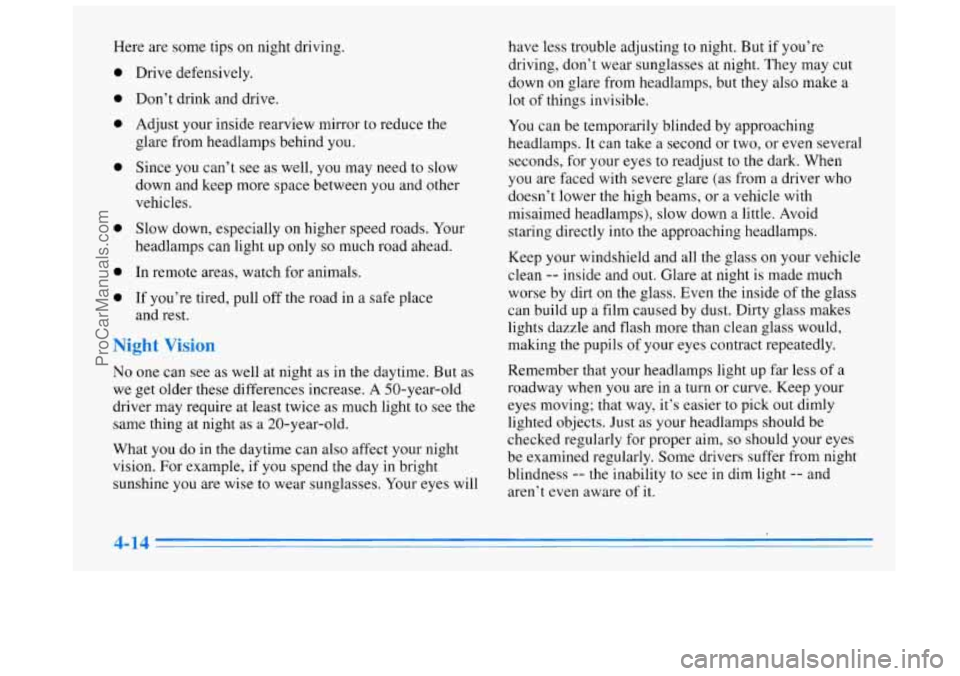
Here are some tips on night driving.
0
0
0
0
0
0
0
Drive defensively.
Don’t drink and drive.
Adjust your inside rearview mirror to reduce the
glare from headlamps behind you.
Since you can’t see as well, you may need to slow
down and keep more space between you and other
vehicles.
Slow down, especially on higher speed roads. Your
headlamps can light up only
so much road ahead.
In remote areas, watch for animals.
If you’re tired, pull
off the road in a safe place
and rest.
lrision
No one can see as well at night as in the daytime. But as
we get older these differences increase.
A 50-year-old
driver may require at least twice as much light to see the
same thing at night as a 20-year-old.
What you
do in the daytime can also affect your night
vision. For example, if you spend the day in bright
sunshine you are wise to wear sunglasses. Your eyes will have
less trouble adjusting to night. But if you’re
driving, don’t wear sunglasses at night. They may cut
down on glare from headlamps, but they also make a
lot of things invisible.
You can be temporarily blinded by approaching
headlamps. It can take a second or two, or
even several
seconds, for your eyes to readjust to the dark. When
you are faced with severe glare (as from a driver who
doesn’t lower the high beams, or a vehicle with
misaimed headlamps), slow down a little. Avoid
staring directly into the approaching headlamps.
Keep your windshield and all the glass on your vehicle
clean
-- inside and out. Glare at night is made much
worse by dirt on the glass. Even the inside of the glass
can build up a film caused by dust. Dirty glass makes
lights dazzle and flash more than clean glass would,
making the pupils of your eyes contract repeatedly.
Remember that your headlamps light up far less
of a
roadway when you are in a turn or curve. Keep your
eyes moving; that way, it’s easier to pick out dimly
lighted objects. Just as your headlamps should be
checked regularly for proper aim,
so should your eyes
be examined regularly. Some drivers suffer from night
blindness
-- the inability to see in dim light -- and
aren’t even aware of it.
ProCarManuals.com
Page 242 of 356
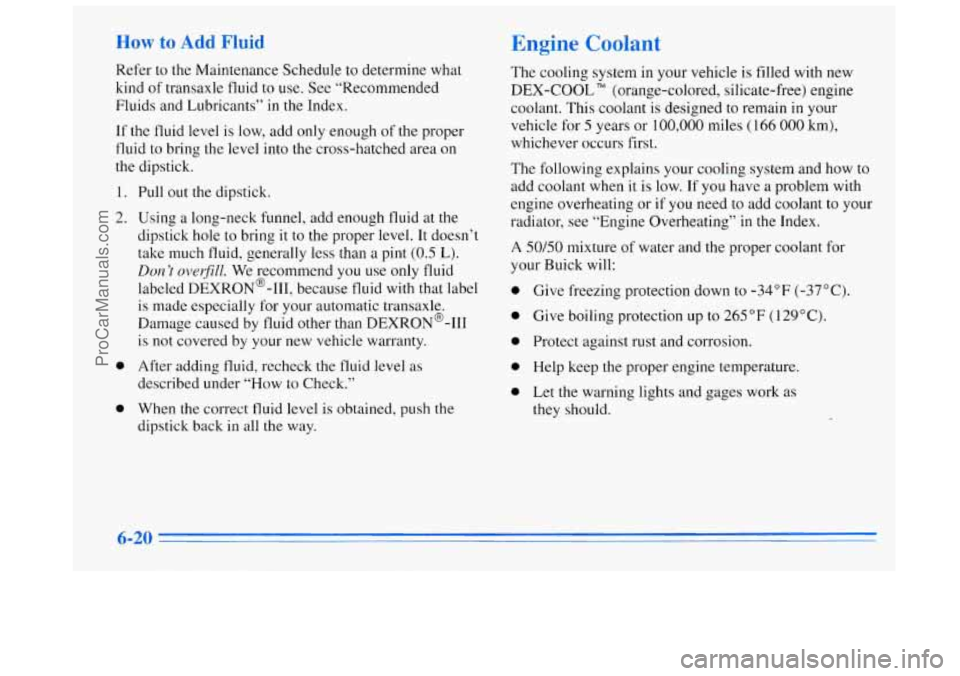
How to Add Fluid
Refer to the Maintenance Schedule to determine what
kind
of transaxle fluid to use. See “Recommended
Fluids and Lubricants’’
in the Index.
If the fluid level is low, add
only enough of the proper
fluid to bring the level into the cross-hatched area on
the dipstick.
1.
2.
0
0
Pull out the dipstick.
Using
a long-neck funnel, add enough fluid at the
dipstick hole to bring
it to the proper level. It doesn’t
take much fluid, generally less than a pint
(0.5 L).
Don t overfill. We recommend you use only fluid
labeled DEXRONO-111, because fluid with that label
is made especially for your automatic transaxle.
Damage caused by fluid other than DEXRON@-I11
is not covered by your new vehicle warranty.
After adding fluid, recheck the fluid level
as
described under “How to Check.”
When
the correct fluid level is obtained, push the
dipstick back in all the way.
Engine Coolant
The cooling system in your vehicle is filled with new
DEX-COOL
TM (orange-colored, silicate-free) engine
coolant. This coolant
is designed to remain in your
vehicle for
5 years or 100,000 miles (166 000 km),
whichever occurs first.
The following explains your cooling system and how to
add coolant when
it is low. If you have a problem with
engine overheating or
if you need to add coolant to your
radiator, see “Engine Overheating” in the Index.
A 50/50 mixture of water and the proper coolant for
your Buick will:
Give freezing protection down to
-34°F (-37°C).
Give boiling protection up
to’ 265 “F ( 129” C).
Protect against rust and corrosion.
Help keep the proper engine temperature.
Let the warning lights and gages work as
they should.
ProCarManuals.com
Page 349 of 356
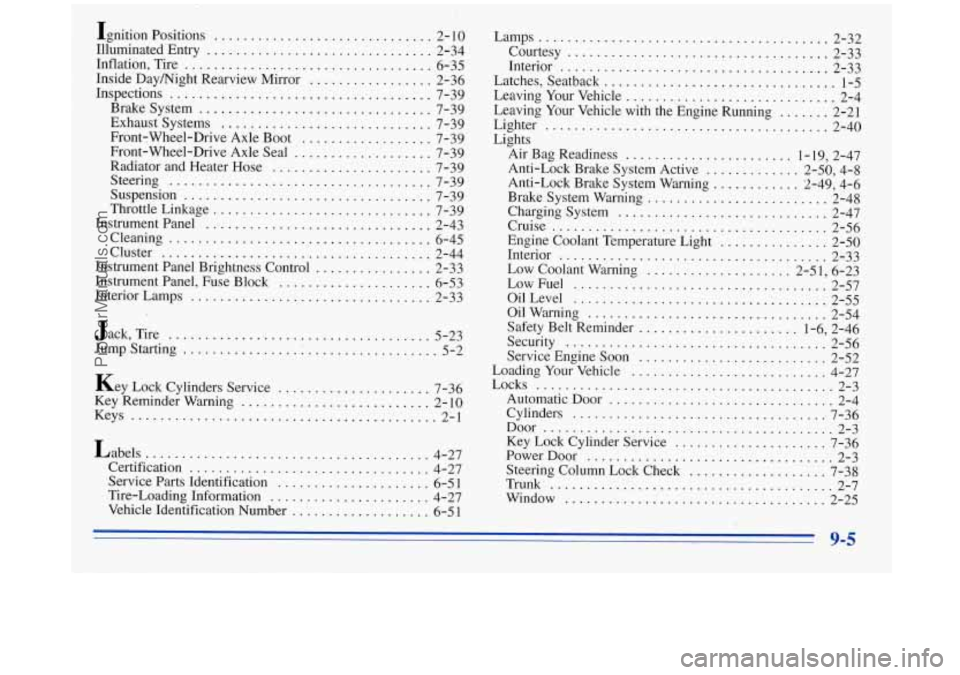
Ignition Positions .............................. 2. 1 o
Illuminated Entry ............................... 2-34
Inflation. Tire
.................................. 6-35
Inside Daymight Rearview Mirror
................. 2-36
Inspections
.................................... 7-39
Brakesystem
................................ 7-39
Exhaust Systems
............................. 7-39
Front-Wheel-Drive Axle Boot
.................. 7-39
Front-Wheel-Drive Axle Seal
................... 7-39
Radiator and Heater Hose
...................... 7-39
Steering
.................................... 7-39
Throttle Linkage
.............................. 7-39
Instrumentpanel
............................... 2-43
Cleaning
.................................... 6-45
Cluster
..................................... 2-44
Instrument Panel Brightness Control
................ 2-33
Instrument Panel. Fuse Block
..................... 6-53
InteriorLamps
................................. 2-33
Suspension
.................................. 7-39
.................................... J ack,
Tire 5-23
Jump Starting
................ i .................. 5-2
Key Lock Cylinders Service ..................... 7-36
Key Reminder Warning
.......................... 2- 10
Keys .......................................... 2-1
Labels
....................................... 4-27
Certification
................................. 4-27
Service Parts Identification
..................... 6-5 1
.Tir e-Loading Information ....................... 4-27
Vehicle Identification Number
.................... 6-5 1
Lamps ........................................ 2-32
Courtesy
.................................... 2-33
Interior
..................................... 2-33
Latches, Seatback
................................ 1-5
Leaving Your Vehicle
............................. 2-4
Leaving Your Vehicle with the Engine Running
....... 2-21
Lighter
........................................ 2-40
Lights Air Bag Readiness
....................... 1-19, 2-47
Anti-Lock Brake System Warning
............ 2-49, 4-6
Brake System Warning
......................... 2-48
Charging System
............................. 2-47
Cruise
...................................... 2-56
Engine Coolant Temperature Light
............... 2-50
Interior
..................................... 2-33
Low Coolant Warning
.................... 2-51, 6-23
LowFuel
.................................... 2-57
Anti-Lock Brake System Active
............. 2-50,
4-8
OilLevel
................................... 2-55
Oilwarning
................................. 2-54
Safety Belt Reminder
....................... 1-6, 2-46
Security
..................................... 2-56
Service Engine Soon
.......................... 2-52
Loading Your Vehicle
........................... 4-27
Locks
......................................... 2-3
Automatic Door
............................... 2-4
Cylinders
................................... 7-36
Door
........................................ 2-3
Key Lock Cylinder Service
..................... 7-36
PowerDoor
.................................. 2-3
Steering Column Lock Check
................... 7-38
Trunk
........................................ 2-7
Window
.................................... 2-25
9-5
ProCarManuals.com